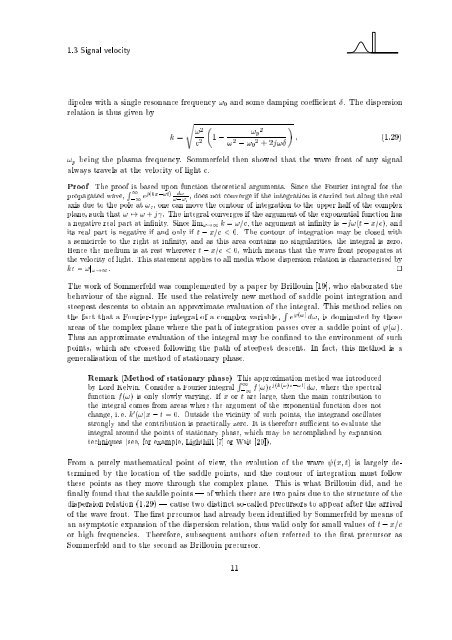Wave Propagation in Linear Media | re-examined
Wave Propagation in Linear Media | re-examined
Wave Propagation in Linear Media | re-examined
Create successful ePaper yourself
Turn your PDF publications into a flip-book with our unique Google optimized e-Paper software.
1.3 Signal velocity<br />
dipoles with a s<strong>in</strong>gle <strong>re</strong>sonance f<strong>re</strong>quency !0 and some damp<strong>in</strong>g coe<br />
<strong>re</strong>lation is thus given by<br />
cient . The dispersion<br />
k =<br />
s ! 2<br />
c 2<br />
!p 2<br />
1 ,<br />
! 2 , !0 2 +2j!<br />
; (1.29)<br />
!p be<strong>in</strong>g the plasma f<strong>re</strong>quency. Sommerfeld then showed that the wave front of any signal<br />
always travels at the velocity of light c.<br />
Proof The proof is based upon function theo<strong>re</strong>tical arguments. S<strong>in</strong>ce the Fourier <strong>in</strong>tegral for the<br />
propagated wave, R 1<br />
d!<br />
ej(kx,!t)<br />
,1 , does not converge if the <strong>in</strong>tegration is carried out along the <strong>re</strong>al<br />
!,!c<br />
axis due to the pole at !c, one can move the contour of <strong>in</strong>tegration to the upper half of the complex<br />
plane, such that ! 7! ! + j . The <strong>in</strong>tegral converges if the argument of the exponential function has<br />
a negative <strong>re</strong>al part at <strong>in</strong> nity. S<strong>in</strong>ce lim!!1 k = !=c, the argument at <strong>in</strong> nity is,j!(t , x=c), and<br />
its <strong>re</strong>al part is negative if and only if t , x=c < 0. The contour of <strong>in</strong>tegration may be closed with<br />
a semicircle to the right at <strong>in</strong> nity, and as this a<strong>re</strong>a conta<strong>in</strong>s no s<strong>in</strong>gularities, the <strong>in</strong>tegral is zero.<br />
Hence the medium is at <strong>re</strong>st whe<strong>re</strong>ver t , x=c < 0, which means that the wave front propagates at<br />
the velocity of light. This statement applies to all media whose dispersion <strong>re</strong>lation is characterised by<br />
kc = !j!!1.<br />
The work of Sommerfeld was complemented by a paper by Brillou<strong>in</strong> [19], who elaborated the<br />
behaviour of the signal. He used the <strong>re</strong>latively new method of saddle po<strong>in</strong>t <strong>in</strong>tegration and<br />
steepest descents to obta<strong>in</strong> an approximate evaluation of the <strong>in</strong>tegral. This method <strong>re</strong>lies on<br />
the fact that a Fourier-type <strong>in</strong>tegral of a complex variable, R e '(!) d!, is dom<strong>in</strong>ated by those<br />
a<strong>re</strong>as of the complex plane whe<strong>re</strong> the path of <strong>in</strong>tegration passes over a saddle po<strong>in</strong>t of'(!).<br />
Thus an approximate evaluation of the <strong>in</strong>tegral may be con ned to the environment of such<br />
po<strong>in</strong>ts, which a<strong>re</strong> crossed follow<strong>in</strong>g the path of steepest descent. In fact, this method is a<br />
generalisation of the method of stationary phase.<br />
Remark (Method of stationary phase) This approximation method was <strong>in</strong>troduced<br />
by Lord Kelv<strong>in</strong>. Consider a Fourier <strong>in</strong>tegral R 1<br />
,1 f(!)ej(k(!)x,!t) d!, whe<strong>re</strong> the spectral<br />
function f(!) is only slowly vary<strong>in</strong>g. If x or t a<strong>re</strong> large, then the ma<strong>in</strong> contribution to<br />
the <strong>in</strong>tegral comes from a<strong>re</strong>as whe<strong>re</strong> the argument of the exponential function does not<br />
change, i. e. k0 (!)x , t =0. Outside the vic<strong>in</strong>ity of such po<strong>in</strong>ts, the <strong>in</strong>tegrand oscillates<br />
strongly and the contribution is practically zero. It is the<strong>re</strong>fo<strong>re</strong> su cient toevaluate the<br />
<strong>in</strong>tegral around the po<strong>in</strong>ts of stationary phase, which maybe accomplished by expansion<br />
techniques (see, for example, Lighthill [7] or Wait [20]).<br />
From a pu<strong>re</strong>ly mathematical po<strong>in</strong>t of view, the evolution of the wave (x; t) is largely determ<strong>in</strong>ed<br />
by the location of the saddle po<strong>in</strong>ts, and the contour of <strong>in</strong>tegration must follow<br />
these po<strong>in</strong>ts as they move through the complex plane. This is what Brillou<strong>in</strong> did, and he<br />
nally found that the saddle po<strong>in</strong>ts | of which the<strong>re</strong> a<strong>re</strong> two pairs due to the structu<strong>re</strong> of the<br />
dispersion <strong>re</strong>lation (1.29) | cause two dist<strong>in</strong>ct so-called p<strong>re</strong>cursors to appear after the arrival<br />
of the wave front. The rst p<strong>re</strong>cursor had al<strong>re</strong>ady been identi ed by Sommerfeld by means of<br />
an asymptotic expansion of the dispersion <strong>re</strong>lation, thus valid only for small values of t , x=c<br />
or high f<strong>re</strong>quencies. The<strong>re</strong>fo<strong>re</strong>, subsequent authors often <strong>re</strong>fer<strong>re</strong>d to the rst p<strong>re</strong>cursor as<br />
Sommerfeld and to the second as Brillou<strong>in</strong> p<strong>re</strong>cursor.<br />
11












